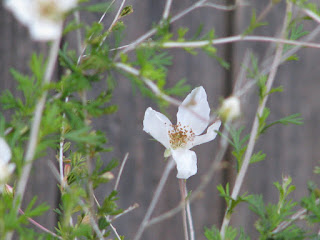Well, not me, but my garden was certified by the National Wildlife Federation as a Backyard Wildlife Habitat . I applied for the Best of Backyards program through Texas Parks and Wildlife Department. In addition to the NWF certification, I received a Texas Wildscape certificate from TPWD and a Best of Texas Backyard Habitats certificate from TPWD and the NWF.
The wildlife that frequents my garden is usually small. Insects, birds, lizards, plant-eating rabbits, neighbor's bird-killing cats, hole-digging, acorn-planting squirrels, and opossums. The neighborhood is bordered by major streets, so unless wildlife is already here, can fly or animals escape from a circus train, that is about all the wildlife I will ever see in my garden.
Here is an example of some wildlife that carried out its life cycle in my garden. Last year in September, I noticed tiny pipevine swallowtail caterpillars on my pipevine. As the leaves disappeared, the caterpillars grew. The first photo is from October 2008.

The pipevine was in its second year. I thought there would be enough leaves to sustain the caterpillars, but the started stripping the leaves very quickly. They are not the brightest creatures either. Although perfectly tasty leaves were still available for them, I assume they could not find them, so several of the caterpillars took off on a journey searching for more food. If I noticed them wandering off, I returned them to the vine and they immediately resumed munching on the leaves.
Over time, the numbers of caterpillars dwindled. I do not know if they set off on one of their journeys and died or became food for a wasp or bird. Maybe they just went off somewhere to pupate. In the end, I only know where two of them pupated. The creatures pupated through the winter. I was not sure if they were dead or alive. Then one day in March 2009 I notice one had emerged as a butterfly. Later that day, I noticed a butterfly had emerged from the other pupa and was waiting for its wings to extend and fill with fluid.  The wings looked small, so I thought it would take a while before the butterfly would fly off. I walked away for a few minutes and when I came back to take more pictures the butterfly flew up into a neighbor's tree. I was able to get one last shot of my backyard wildlife.
The wings looked small, so I thought it would take a while before the butterfly would fly off. I walked away for a few minutes and when I came back to take more pictures the butterfly flew up into a neighbor's tree. I was able to get one last shot of my backyard wildlife. The life cycle continues. There are two clusters of pipevine swallowtail eggs on the pipevine now. Are they from one of my butterflies? Could be. Will there be enough leaves to sustain all the hungry caterpillars? I hope so.
The life cycle continues. There are two clusters of pipevine swallowtail eggs on the pipevine now. Are they from one of my butterflies? Could be. Will there be enough leaves to sustain all the hungry caterpillars? I hope so.
 Apache Plume Fallugia paradoxa
Apache Plume Fallugia paradoxa Granny Grimmets Antique Rose
Granny Grimmets Antique Rose  Chocolate Daisy Berlandier lyrata
Chocolate Daisy Berlandier lyrata From top left corner: Penstemon digitalis 'Husker Red', Rosemary Rosmarinus officinalis, Salvia farinacea 'Henry Duelberg', Compact Texas Sage Leucophyllum frutescens 'Compactum', more Husker Red penstemon, Texas Betony Stachys coccinea, Bronze Fennel Foeniculum vulgare, Garden Phlox Phlox paniculata, Cherokee Sedge Carex cherokeensis, and Hardy Amarylis Hippeastrum x johnsonii
From top left corner: Penstemon digitalis 'Husker Red', Rosemary Rosmarinus officinalis, Salvia farinacea 'Henry Duelberg', Compact Texas Sage Leucophyllum frutescens 'Compactum', more Husker Red penstemon, Texas Betony Stachys coccinea, Bronze Fennel Foeniculum vulgare, Garden Phlox Phlox paniculata, Cherokee Sedge Carex cherokeensis, and Hardy Amarylis Hippeastrum x johnsonii







